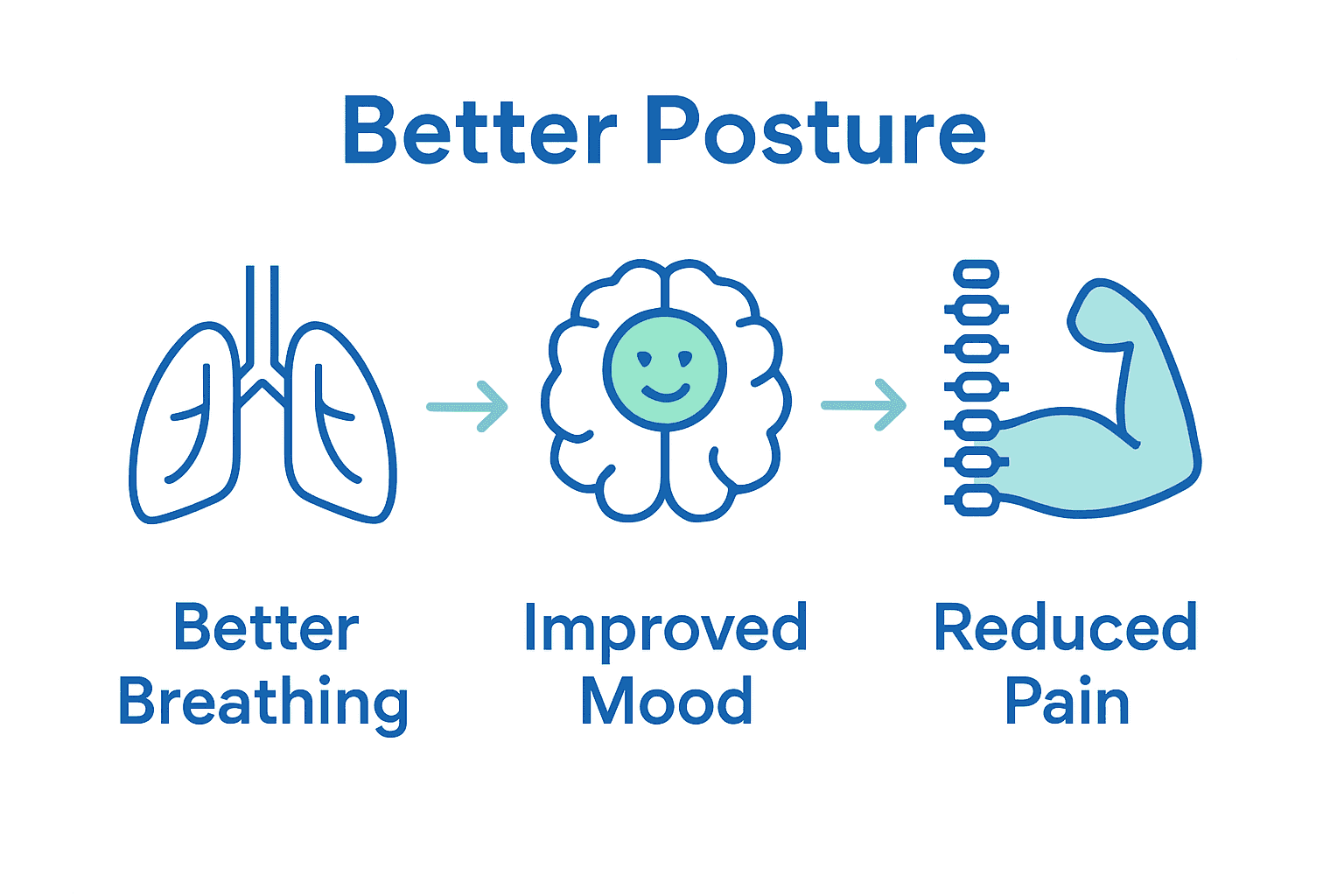Why Posture Matters: Complete Guide
- Nov 10
- 6 min read

Most people think posture means standing perfectly straight, yet over 80 percent of adults experience back pain partly due to poor alignment causing fatigue of critical musculature in the neck and upper back. The way you sit, stand, and move affects far more than just your appearance. Posture quietly influences your breathing, energy, comfort, and even your mood. Understanding what posture truly is—and clearing up the common myths—can transform your overall health and help you avoid long-term discomfort.
Table of Contents
Key Takeaways
Point | Details |
Posture is Dynamic | Good posture involves the alignment and balance of the body, not just standing straight. It is a dynamic state that supports overall health and movement. |
Impact on Health | Poor posture may affect respiratory, digestive, and musculoskeletal functions, leading to larger health challenges beyond discomfort. |
Mind-Body Connection | Posture influences self-confidence, mood, and cognitive performance, emphasizing the psychological aspects of body language. |
Long-Term Improvement | Enhancing posture requires ongoing awareness and strategies like strength training, ergonomic adjustments, and flexibility exercises to support natural alignment. |
Defining Posture And Common Misconceptions
When you hear the word “posture,” what comes to mind? Most people picture someone standing ramrod straight, shoulders pulled back like a military recruit. But posture is far more nuanced and complex than simply standing at attention. According to Alexander Technique Canada, posture involves the complete alignment and balance of the body, which goes well beyond a static position.
Contrary to popular belief, good posture isn’t about rigidity or constantly forcing yourself into an uncomfortable stance. It’s a dynamic state of bodily coordination that supports your overall health and movement. Alexander Technique Canada highlights that poor posture can significantly impact fundamental bodily functions, potentially impeding breathing, disrupting digestion, and creating musculoskeletal challenges.
Key misconceptions about posture include:
Posture is just about standing straight
Good posture means being stiff and rigid
Only athletes or physically active people need to worry about posture
Posture is purely cosmetic and doesn’t affect health
In reality, posture is a holistic concept that reflects how your muscles, joints, and skeletal structure work together. It’s a dynamic process influenced by everything from your daily habits and stress levels to your physical conditioning and muscle strength. Understanding posture means recognizing it as a fluid, ongoing interaction between your body’s systems, not a fixed state you can achieve through willpower alone.
How Posture Impacts Physical Functions
Your body is an intricate system where every component is interconnected, and posture plays a crucial role in maintaining this delicate balance. National Geographic reveals that poor posture isn’t just about appearance - it can profoundly impact multiple physical functions, creating a cascade of health challenges that extend far beyond simple discomfort.
One of the most significant ways posture affects physical health is through respiratory function. When you slouch or maintain a compressed body position, your lung capacity diminishes. This reduction means less oxygen intake, which might lead to decreased energy levels, reduced cognitive performance, and increased fatigue. National Geographic highlights that poor posture can directly influence oxygen intake, potentially compromising your body’s fundamental ability to breathe efficiently.
The ripple effects of poor posture extend to multiple body systems:
Muscular System: Increased muscle strain and uneven load distribution
Digestive System: Potential compression of internal organs
Hormonal Balance: Potential disruption of stress hormone production
Circulatory System: Restricted blood flow and potential cardiovascular strain
Beyond these immediate impacts, chronic poor posture can lead to long-term structural changes in your body. Misalignment can cause uneven wear on joints, create muscular imbalances, and potentially lead to persistent pain conditions. Your posture is essentially a window into your overall physical health, reflecting not just how you move, but how effectively your body’s systems are functioning.

Posture’s Role In Mental And Emotional Health
Posture is more than just a physical state - it’s a powerful window into our mental and emotional landscape. Body language speaks volumes, and the way we hold ourselves can profoundly influence our psychological well-being. Education News Canada reveals a fascinating connection between body perception and cognitive performance, demonstrating that our self-image directly impacts how we learn and move.
Research from the University of Toronto suggests that self-consciousness about our body can create a cycle of negative emotional experiences. When individuals feel uncomfortable or critical about their physical stance, it triggers a cascade of psychological responses. Education News Canada highlights that this self-perception can dramatically reduce performance in movement-related tasks, creating a self-reinforcing pattern of diminished confidence and reduced physical capability.
Key psychological impacts of posture include:
Influence on self-confidence
Impact on mood and emotional regulation
Connection to stress and anxiety levels
Effect on social interactions and perceived approachability
The mind-body connection runs deep. When you adopt an open, upright posture, you’re not just aligning your physical structure - you’re sending powerful signals to your brain about your emotional state. Expansive, confident postures can actually trigger the release of hormones like testosterone and reduce stress hormones, creating a neurological feedback loop that can transform your mental and emotional experience.
Why Posture Affects Musculoskeletal Injury Risk
Musculoskeletal injuries are not random occurrences but often the result of cumulative stress and biomechanical imbalances. University of Waterloo research reveals that posture plays a critical role in determining our vulnerability to physical strain and potential injuries. The way we position our body, particularly our trunk and low back, directly influences our ability to withstand physical stress and perform complex movement tasks.
A key finding from the study highlights that trunk muscle coordination and posture significantly impact isometric lifting strength. University of Waterloo recommends avoiding highly flexed low back postures during physically demanding activities to minimize musculoskeletal injury risk. IMPACT Magazine further emphasizes that good posture increases the body’s capacity to safely handle physical loads, essentially acting as a protective mechanism against potential injuries.
Critical factors that increase musculoskeletal injury risk include:

Prolonged poor posture
Repetitive movements with incorrect body alignment
Excessive strain on specific muscle groups
Lack of core muscle strength and stability
Uneven weight distribution during physical activities
By understanding and implementing proper postural techniques, you can significantly reduce your risk of musculoskeletal injuries. This means being mindful of your body’s alignment during both static and dynamic movements, strengthening supporting muscle groups, and avoiding sustained positions that place undue stress on your joints and muscles. Check out our guide on physiotherapy for pain relief to learn more about maintaining optimal musculoskeletal health.
Methods To Improve Posture Long-Term
Improving posture isn’t a quick fix but a holistic journey that requires consistent awareness and strategic interventions. Calgary Foothills Primary Care Network emphasizes that body positioning is fundamental to long-term postural health, recommending frequent repositioning and conscious movement patterns that support natural alignment.
TurnFit Personal Trainers highlight that proper posture involves more than just standing straight - it’s about muscle activation and weight distribution. Their research suggests being mindful of how you distribute weight when standing and ensuring your spine maintains a natural, aligned position during both static and dynamic activities.
Key long-term posture improvement strategies include:
Regular strength training focusing on core muscles
Periodic postural assessments
Ergonomic workspace modifications
Conscious movement and position shifting
Flexibility and mobility exercises
Consistent practice is crucial. Think of posture improvement like learning a new skill - it requires patience, dedication, and gradual progression. Explore our exercise resources to discover targeted movements that can help you develop better postural habits and muscle support over time. Remember, small, intentional changes compound into significant long-term improvements in how your body moves, feels, and functions.
Take Control of Your Posture and Protect Your Health Today
Understanding why posture matters is the first step to preventing pain, improving breathing, and safeguarding yourself from musculoskeletal injuries. If poor posture or discomfort is holding you back from feeling confident and energized, now is the time to make a proactive change. This is not just about standing tall but nurturing your body’s natural alignment and movement with expert care.

At Integrate Healthcare Clinic, our team approach combines physiotherapy, chiropractic care, and massage therapy to support your journey toward lasting postural health. Discover personalized treatments designed to rebuild strength, enhance flexibility, and reduce injury risk. Don’t wait for pain to worsen or posture to decline. Visit Integrate Ottawa to learn more about our evidence-based services and book an appointment. Your body deserves care that transforms how you feel every day.
Frequently Asked Questions
What is posture, and why is it important?
Posture refers to the alignment and balance of the body, impacting overall health, movement, and physical functions. Good posture supports respiratory function, digestion, and musculoskeletal health, while poor posture can lead to various health issues.
How does poor posture affect physical health?
Poor posture can hinder respiratory function, reduce oxygen intake, disrupt digestion, and create musculoskeletal challenges. It can lead to increased muscle strain, joint wear, and long-term pain conditions.
Can posture influence mental and emotional well-being?
Yes, posture significantly impacts mental and emotional health. Open, confident postures can boost self-confidence, improve mood, and reduce stress levels, while poor posture can lead to negative self-image and decreased performance.
What are effective methods to improve posture long-term?
To improve posture long-term, incorporate regular strength training focusing on core muscles, ergonomic workspace modifications, periodic postural assessments, flexibility exercises, and conscious movement practice.
Recommended

Comments